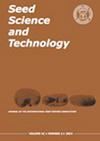Biocontrol of bacterial fruit blotch by seed priming with Bacillus amyloliquefaciens and Pseudomonas fluorescens
IF 3
4区 农林科学
Q2 AGRONOMY
引用次数: 0
Abstract
Bacterial fruit blotch (BFB), caused by the seed-transmitted pathogen Acidovorax citrulli, poses a serious threat to cucurbitaceous crops worldwide. In this study, two biocontrol bacteria strains, Bacillus amyloliquefaciens (Ba-2) and Pseudomonas fluorescens (2P24), with significant antagonistic activity against A. citrulli were and applied by seed priming to control BFB seed transmission. Artificially infested watermelon and melon seeds were treated with the biocontrol strains by liquid or solid matrix seed priming. The seed bio-priming effects were evaluated under greenhouse conditions. Germination percentages were improved by seed priming treatments for melon, and seedling uniformity was higher for seeds primed with Ba-2 than for seeds from the other treatments for watermelon. Seedling disease incidence of untreated seeds were 6.5% for watermelon and 16.0% for melon, and water-priming resulted in similar disease progress curves as the untreated control. Seed priming with Ba-2 and 2P24 significantly reduced seedling BFB incidence for both watermelon and melon. Evaluation with naturally infested watermelon seeds primed with biocontrol strains indicated that 2P24 seed priming was more effective than Ba-2 (P < 0.05) and 2P24 solid matrix priming, reducing the seedling disease incidence to 1.3%. Seed bio-priming has potential as an effective and eco-friendly approach for suppressing bacterial fruit blotch seed-to-seedling transmission.解淀粉芽孢杆菌和荧光假单胞菌种子诱导生物防治细菌性水果斑病
细菌性水果斑病(Bacterial fruit blotch, BFB)是由瓜酸霉(Acidovorax citrulli)种子传播的病原菌引起的一种严重威胁瓜类作物的疾病。本研究采用种子引物的方法,利用解淀粉芽孢杆菌(Bacillus amyloliquefaciens, Ba-2)和荧光假单胞菌(Pseudomonas fluorescens, 2P24)两株对瓜蚜具有显著拮抗活性的生防菌,对瓜蚜的种子传播进行了控制。采用液体或固体基质引种法对人工侵染的西瓜和瓜子进行生物防治。在温室条件下对种子的生物引种效应进行了评价。灌种处理提高了甜瓜种子的发芽率,灌种后种子的幼苗均匀性高于其他处理。西瓜和甜瓜幼苗病害发生率分别为6.5%和16.0%,引水处理导致的病害进展曲线与未处理对照相似。Ba-2和2P24对西瓜和甜瓜幼苗BFB发生率均有显著降低。以自然侵染的西瓜种子为试验材料,经生物防治菌株处理后,2P24种子处理的效果优于Ba-2 (P < 0.05)和2P24固体基质处理,将西瓜幼苗病害发生率降低至1.3%。种子生物诱导是抑制细菌性果斑病从种子到幼苗传播的一种有效且环保的方法。
本文章由计算机程序翻译,如有差异,请以英文原文为准。
求助全文
约1分钟内获得全文
求助全文
来源期刊

Seed Science and Technology
农林科学-农艺学
CiteScore
3.00
自引率
28.60%
发文量
36
审稿时长
>36 weeks
期刊介绍:
Seed Science and Technology (SST) is an international journal featuring original papers and articles on seed quality and physiology related to seed production, harvest, processing, sampling, storage, genetic conservation, habitat regeneration, distribution and testing. A journal that meets the needs of researchers, advisers and all those involved in the improvement and technical control of seed quality. Published every April, August and December.
 求助内容:
求助内容: 应助结果提醒方式:
应助结果提醒方式:


